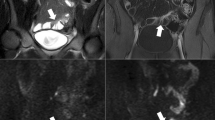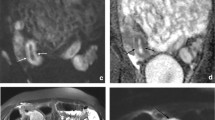Abstract
Background
Small-bowel MRI based on contrast-enhanced T1-weighted sequences has been challenged by diffusion-weighted imaging (DWI) for detection of inflammatory bowel lesions and complications in patients with Crohn disease.
Objective
To evaluate free-breathing DWI, as compared to contrast-enhanced MRI, in children, adolescents and young adults with Crohn disease.
Materials and methods
This retrospective study included 33 children and young adults with Crohn disease ages 17 ± 3 years (mean ± standard deviation) and 27 matched controls who underwent small-bowel MRI with contrast-enhanced T1-weighted sequences and DWI at 1.5 T. The detectability of Crohn manifestations was determined. Concurrent colonoscopy as reference was available in two-thirds of the children with Crohn disease.
Results
DWI and contrast-enhanced MRI correctly identified 32 and 31 patients, respectively. All 22 small-bowel lesions and all Crohn complications were detected. False-positive findings (two on DWI, one on contrast-enhanced MRI), compared to colonoscopy, were a result of large-bowel lumen collapse. Inflammatory wall thickening was comparable on DWI and contrast-enhanced MRI. DWI was superior to contrast-enhanced MRI for detection of lesions in 27% of the assessed bowel segments and equal to contrast-enhanced MRI in 71% of segments.
Conclusion
DWI facilitates fast, accurate and comprehensive workup in Crohn disease without the need for intravenous administration of contrast medium. Contrast-enhanced MRI is superior in terms of spatial resolution and multiplanar acquisition.




Similar content being viewed by others
References
Hyams JS (1996) Crohn’s disease in children. Pediatr Clin North Am 43:255–277
Loftus EV (2004) Clinical epidemiology of inflammatory bowel disease: Incidence, prevalence, and environmental influences. Gastroenterology 126:1504–1517
Diefenbach KA, Breuer CK (2006) Pediatric inflammatory bowel disease. World J Gastroenterol 12:3204–3212
Desmond AN, O’Regan K, Curran C et al (2008) Crohn’s disease: factors associated with exposure to high levels of diagnostic radiation. Gut 57:1524–1529
Peloquin JM, Pardi DS, Sandborn WJ et al (2008) Diagnostic ionizing radiation exposure in a population-based cohort of patients with inflammatory bowel disease. Am J Gastroenterol 103:2015–2022
Alison M, Kheniche A, Azoulay R et al (2007) Ultrasonography of Crohn disease in children. Pediatr Radiol 37:1071–1082
Semelka RC, Shoenut JP, Silverman R et al (1991) Bowel disease: prospective comparison of CT and 1.5-T pre- and postcontrast imaging with T1-weighted fat-suppressed and breath-hold FLASH sequences. J Magn Reson Imaging 1:625–632
Shoenut JP, Semelka RC, Magro CM et al (1994) Comparison of magnetic resonance imaging and endoscopy in distinguishing the type and severity of inflammatory bowel disease. J Clin Gastroenterol 19:31–35
Siddiki H, Fidler J (2009) MR imaging of the small bowel in Crohn’s disease. Eur J Radiol 69:409–417
Kettritz U, Isaacs K, Warshauer DM et al (1995) Crohn’s disease. Pilot study comparing MRI of the abdomen with clinical evaluation. J Clin Gastroenterol 21:249–253
Horsthuis K, Bipat S, Stokkers PCF et al (2009) Magnetic resonance imaging for evaluation of disease activity in Crohn’s disease: a systematic review. Eur Radiol 19:1450–1460
Horsthuis K, Lavini C, Stoker J (2005) MRI in Crohn’s disease. J Magn Reson Imaging 22:1–12
Gee MS, Nimkin K, Hsu M et al (2011) Prospective evaluation of MR enterography as the primary imaging modality for pediatric Crohn disease assessment. AJR 197:224–231
Punwani S, Rodriguez-Justo M, Bainbridge A et al (2009) Mural inflammation in Crohn disease: location-matched histologic validation of MR imaging features. Radiology 252:712–720
Kiryu S, Dodanuki K, Takao H et al (2009) Free-breathing diffusion-weighted imaging for the assessment of inflammatory activity in Crohn’s disease. J Magn Reson Imaging 29:880–886
Oto A, Zhu F, Kulkarni K et al (2009) Evaluation of diffusion-weighted MR imaging for detection of bowel inflammation in patients with Crohn’s disease. Acad Radiol 16:597–603
Oto A, Kayhan A, Williams JT et al (2011) Active Crohn’s disease in the small bowel: evaluation by diffusion weighted imaging and quantitative dynamic contrast enhanced MR imaging. J Magn Reson Imaging 33:615–624
Laghi A, Borrelli O, Paolantonio P et al (2003) Contrast enhanced magnetic resonance imaging of the terminal ileum in children with Crohn’s disease. Gut 52:393–397
Toma P, Granata C, Magnano G et al (2007) CT and MRI of paediatric Crohn disease. Pediatr Radiol 37:1083–1092
Alexopoulou E, Roma E, Loggitsi D et al (2009) Magnetic resonance imaging of the small bowel in children with idiopathic inflammatory bowel disease: evaluation of disease activity. Pediatr Radiol 39:791–797
Sauer CG, Kugathasan S, Martin DR et al (2011) Medical radiation exposure in children with inflammatory bowel disease estimates high cumulative doses. Inflamm Bowel Dis 17:2326–2332
Wiarda BM, Kuipers EJ, Houdijk LP et al (2005) MR enteroclysis: imaging technique of choice in diagnosis of small bowel diseases. Dig Dis Sci 50:1036–1040
Oussalah A, Laurent V, Bruot O et al (2010) Diffusion-weighted magnetic resonance without bowel preparation for detecting colonic inflammation in inflammatory bowel disease. Gut 59:1056–1065
Gahr N, Darge K, Hahn G et al (2011) Diffusion-weighted MRI for differentiation of neuroblastoma and ganglioneuroblastoma/ganglioneuroma. Eur J Radiol 79:443–446
Low RN, Francis IR (1997) MR imaging of the gastrointestinal tract with i.v., gadolinium and diluted barium oral contrast media compared with unenhanced MR imaging and CT. AJR 169:1051–1059
Del Vescovo R, Sansoni I, Caviglia R et al (2008) Dynamic contrast enhanced magnetic resonance imaging of the terminal ileum: differentiation of activity of Crohn’s disease. Abdom Imaging 33:417–424
Florie J, Wasser MN, Arts-Cieslik K et al (2006) Dynamic contrast-enhanced MRI of the bowel wall for assessment of disease activity in Crohn’s disease. AJR 186:1384–1392
Pauls S, Kratzer W, Rieber A et al (2003) [Quantifying the inflammatory activity in Crohn’s disease using CE dynamic MRI] (in German). Rofo 175:1093–1099
Umschaden HW, Szolar D, Gasser J et al (2000) Small-bowel disease: comparison of MR enteroclysis images with conventional enteroclysis and surgical findings. Radiology 215:717–725
Martinez MJ, Ripolles T, Paredes JM et al (2009) Assessment of the extension and the inflammatory activity in Crohn’s disease: comparison of ultrasound and MRI. Abdom Imaging 34:141–148
Dillman JR, Ladino-Torres MF, Adler J et al (2011) Comparison of MR enterography and histopathology in the evaluation of pediatric Crohn disease. Pediatr Radiol 41:1552–1558
Bilgili MY (2012) Reproductibility of apparent diffusion coefficients measurements in diffusion-weighted MRI of the abdomen with different b values. Eur J Radiol 81:2066–2068
Acknowledgments
We would like to thank our Medical Radiation Technologists Mrs. C. Doernfeld and Mrs. U. Pytlik and the MR imaging team for performing the MRI scans and for taking care of patients and parents. We also thank Dr. N. Hassold for correcting the manuscript and spell-checking.
Conflicts of interest
The authors have no conflicts of interest to declare.
Author information
Authors and Affiliations
Corresponding author
Rights and permissions
About this article
Cite this article
Neubauer, H., Pabst, T., Dick, A. et al. Small-bowel MRI in children and young adults with Crohn disease: retrospective head-to-head comparison of contrast-enhanced and diffusion-weighted MRI. Pediatr Radiol 43, 103–114 (2013). https://doi.org/10.1007/s00247-012-2492-1
Received:
Revised:
Accepted:
Published:
Issue Date:
DOI: https://doi.org/10.1007/s00247-012-2492-1




